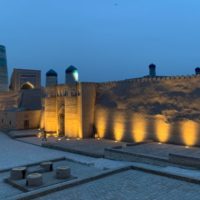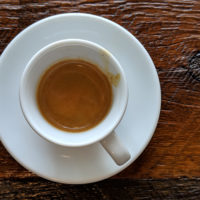The captain pointed right. I yanked the wheel hard, determined to stay on course. The kindly man paid no heed to my non-existent navigational skills and watched as I inexpertly guided the passenger ship across the Dardanelles. “Today you have boats to go across but two hundred years ago, your Lord Byron swam across this strait. It was called Hellespont back then.”
His eyes shone at the thought.
Canakkale, Turkey
My eyes scanned the Dardanelles crawling with passenger and cargo ferries, while my mind dreamed up the picture of young Byron throwing himself into the waters. Perhaps today’s Dardanelles was harder to love or swim than it was in 1810? I would never know. On the shores of Cannakale, my destination, modern buildings and cafes were unimaginatively laid out. What had brought Byron to this part of the world? Did he ever live there?
The captain continued. “His best work was inspired by our legendary Hero and Leander who died in these waters. You must read it.”

I felt a sense of déjà vu as I walked along the pier that evening. I’d been reading Byron’s The Bride of Abydos, and had the sudden feeling that “mad, bad Byron” was walking alongside me. I looked for evidence of his presence, but there was none to find but, but history laced with imagination has a peculiar way of finding its way into the present – like it was doing now. It was then I knew I was in love with Lord Byron.
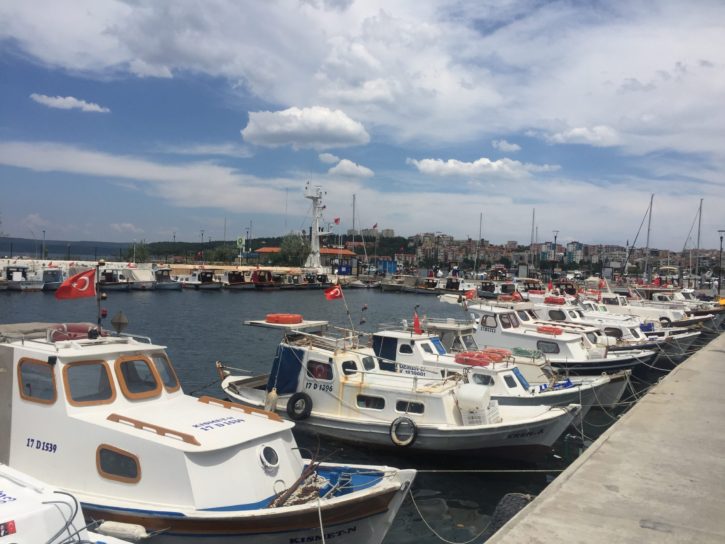
When I returned to Istanbul, I’d read everything about him. It amused me that the infamous poet had escaped creditors in England by going on a Grand Tour as any young nobleman in the days, but whose attraction to Islam and Sufi mysticism had led him to the shores of Constantinople.
Thus idea of tracing Byron’s footsteps thus led me to revisit the spots in Istanbul, like the Hagia Sophia and City Walls that had fascinated him. I tried to establish a connection with Byron through these places and soon enough, the sight of Turkish burial grounds became “the loveliest spots on earth.” Like Byron, there was perhaps a darker side of me too.
I was determined to visit as many places he had set foot on through his journey across Europe.
Lausanne, Switzerland
Lausanne could hardly be described as an artistic hotspot but in 1816, a notorious group headed by George Gordon Lord Byron and his personal physician had arrived here, befriended young poet Percy Shelly, his mistress Mary and her sister Claire and remained there for some time. This group frequently met at Hotel de l’Ancre (now Hotel Angleterre) and had gone sailing on the Lake when weather permitted.
Fortunately in Switzerland it was easy to follow Byron’s tracks for I had a Swiss Pass that allowed me unlimited travel on fast trains and boats. I promptly bent my steps to Hotel Angleterre where Byron had once lived. The hotel had changed since 1816, I was told.
“But you can still feel the presence of greatness in these walls. Lord Byron had been our honoured guest.”
There was heaviness in the air. The walls oozed history. Well-dressed women with dogs under the table looked every bit as elegant as they’d probably have in Byron’s time. Byron chose his places well. It was just as well that Byron’s disrepute had transformed into something of admiration today.
A day later, the Swiss train bore me to Montreux on the Swiss Riviera and gateway to Chillon Castle. Once here, I opted for the Byronic-route of getting there, via the ferry.
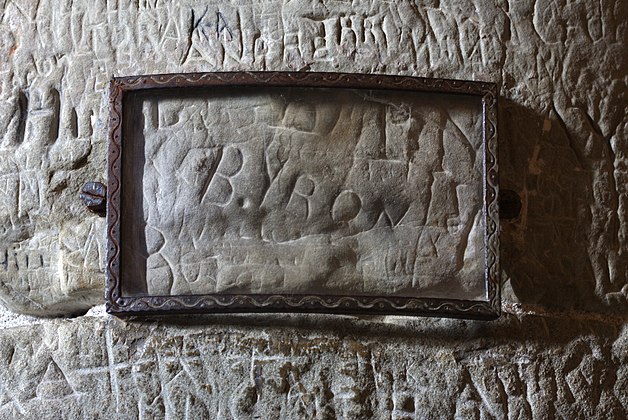
Chillon Castle sprang out of Lake Leman, forlorn and cold, overlooked by the Savoy Mountains. The castle itself had appealed to Byron, it was a great place to visit, but I agreed with his declaration that ‘Chillon was a great place to visit, but I couldn’t imagine living there,’ his impression created by the story of Francois Bonivard, a 15th century patriot who had been chained for four years in the castle’s dungeons. Byron had etched his name on very pillar Bonivard was chained and promptly returned to his rooms at Hotel Angleterre and penned The Prisoner of Chillon in one sitting. It was easy to see why. Chateau Chillon, although the most visit castle in Switzerland, was a testimony to human drama and dark history.
Villa Diadoti, Geneva
When I returned to Geneva, I headed to Cologny, now a luxurious neighbourhood, walking past iron fences and security guards installed in glass booths eyeing me with suspicion to reach Villa Diodati, temporary home of Lord Byron in 1816. The pink villa with its huge balconies had been turned into apartments, but there was a small group of camera- wielding tourists looking for photo-ops and a glimpse of the inside.
I followed the group through the open gate, expecting any moment to be turned back. My mind raced back to a night in the Year Without Summer (1816) when Byron and his friends forced to remain indoors, challenged each other to create a masterpiece. Thus, the villa in which wine flowed and artists gathered by candlelight to discuss and debate, Frankenstein the monster was born of Mary Shelley’s pen.
But it was only a year later that a visit to Hotel Interlaken, a favourite of Lord Byron materialized. I wandered the grounds of this centuries old hotel before allowing myself a cup of coffee. Following this, like Byron, I eventually made my way to Europe’s highest point, Jungfrau, via the picturesque village of Grindelwald which had inspired his creation of Manfred (later adopted by Robert Schumann in 1852). Unfortunately, it was a day that didn’t show Grindelwald at its best, which left me wondering if Western Romanticism would have existed had Grindelwald been as obscured in mist when Lord Byron went through it as it was during my visit?
Probably not.
Padua, Italy
There were two reasons for being in Padua – first, Caffé Pedrocchi, an 18th century café, frequented by Byron and his friend Stendhal, and the second was its proximity to Venice.
Pedrocchi as the locals called it was housed in a neo-classical building at one end of the Piazza, few blocks from the Padua University. This unusual piano-shaped café with tall, Greek columns and classic décor had a reputation of never closing its doors and served the best mint and chocolate flavoured coffee, but that was not the reason I was there. I wanted to feel the place as Byron and his French novelist friend would have as they discussed poetry and politics two centuries ago. The café was busy, but as the piano came to life, the noise from the streets dissipated into moments in history where the greats of Europe and Italy put their heads together over coffee and discussed the world. Today’s Pedrocchi is bigger, with more rooms added but when it opened in 1772, it was the biggest café in Europe.
Venice, Italy
Venice was flooded the morning I arrived, thanks to the rain and the sea burdened with cruise ships bearing thousands of Chinese tourists. Venice was Byron’s “city of the heart, rising from the sea like water columns.” I could see the connection. There was water everywhere. Gondolas passed through narrow waterways, but as I watched them disappear under the Pontei dei Ssospiri, the bridge that connected the Prisons to the interrogation chamber in Doge’s Palace, Venice’s most famous landmarks, Byron came to mind. It was who had named it The Bridge of Sighs. He said thus –
I stood in Venice on the Bridge of Sighs
A palace and a prison at each end…
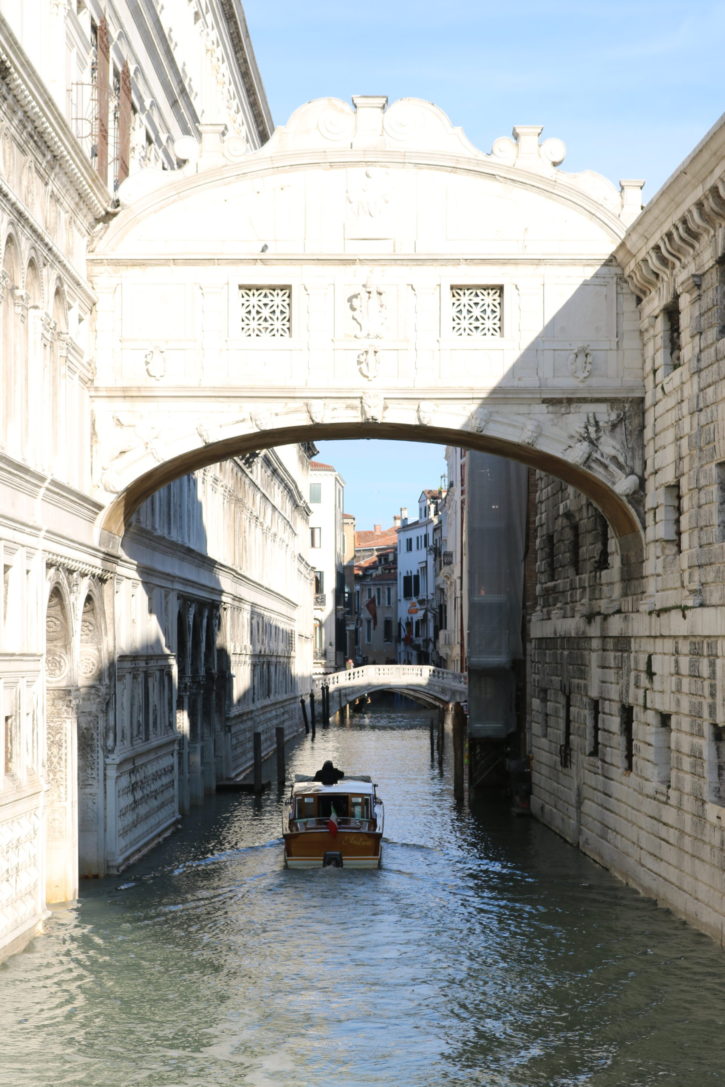
Byron invented the name because, he believed the sighs of the condemned would release as they walked towards death, over the bridge, seeing Venice and freedom for the last time.
From the Bridge of Sighs, I made my way to Caffe Florian at Piazzo San Marco, a Byron-favourite and one of Venice’s earliest establishment that served women, a reason for personalities including Goethe, Casanova and later Lord Byron to visit frequently.
Caffé Florian was almost 300 years old and not cheap, but to share the same space with Byron, two centuries apart, was worth it. Caffe Florian mirrored the spirit of intellectuals that visited here and I sipped coffee and relished buttery scones, and soaked up essence of true Venice. I felt extremely lucky. Was it here, at these white marble tables that Lord Byron drank coffee and cocktails and dallied with the ladies? Perhaps so, for it was at Palazzo Mocenigo that Byron, inspired by his romances with women of all social classes, wrote the first songs of Don Juan.
“Wedded she some years, and to a man
Of fifty, and such husbands are in plenty;
And yet, I think, instead of such a ONE
‘Twere better to have TWO of five and twenty…”
Strangely, in Don Juan, Byron also talked of his swim across the Hellespont nine years earlier.

In some ways, in Venice I’d come full circle, although it was in Greece that he died a National Hero. As I left Venice, I decided to put my obsessions to rest. Greece would have to remain off my Byron-map, because I wanted to think of Lord Byron as the eternal traveler and poet, looking for solace, seeking new pastures, his love for men and women growing, the hunted and the hunter of new experiences…he was alive in my heart.


